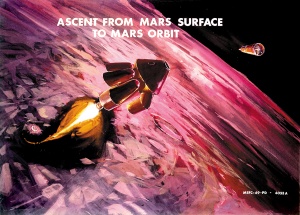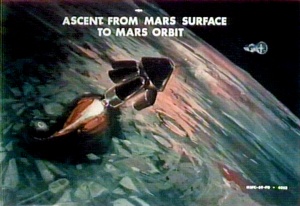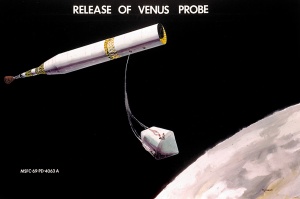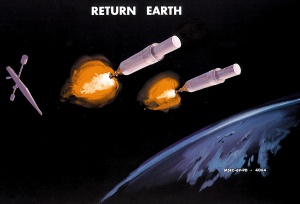Manned Mars Landing by Wernher von Braun Pt 4
From The Space Library
Contents |
ASCENT FROM MARS SURFACE TO MARS ORBIT
Using the MEM descent stage as a launch platform, the ascent stage delivers the crew, scientific data and samples back to the orbiting spaceship. The return payload, consisting mainly of samples, data, and miscellaneous equipment weighs approximately 900 pounds.
Ascent from Mars Surface to Mars Orbit (1970)
Ascent from Mars Surface to Mars Orbit (1969)
MARS DEPARTURE
At the completion of the 80 day period at Mars, the planetary spaceships will begin the return leg of the journey. The nuclear stage is ignited for this propulsive maneuver, boosting each spaceship, out of Mars orbit.
With the extensive Mars exploration activities behind them, the crew at this point can begin a more thorough analysis of the data and samples gathered at Mars, and prepare for the next major milestone of the trip a close encounter with the planet Venus.
Mars Departure
RELEASE VENUS PROBES
In this mission profile, a passage close to Venus during the return leg results in lower approach velocities upon Earth return, and thus lower weight requirements. In addition, this provides an opportunity for close proximity observations and experiments at Venus.
Since clouds obscure the surface of Venus, radar mapping will be conducted to obtain information on surface features. Two probes are provided on each spacecraft, and will be deployed during the Venus passage.
Release of Venus Probe
EARTH RETURN
The manned Mars landing mission concludes with the return to earth orbit, using the last of the propellant in the nuclear stage for the braking maneuver. An optional earth return mode would allow the crew to make direct aerodynamic entry (Apollo-style). Until a better assessment can be made of the back contamination hazard (the return by man of pathogens that might prove harmful to earth inhabitants), a more conservative approach has been planned, i.e. the return of the crew to earth orbit for a quarantine period. Another advantage of the orbit return mode is that the nuclear stage and mission module are available for possible reuse.
Once the spacecraft achieves the desired earth orbit, it will rendezvous with the waiting space base, where the crew will receive thorough medical examinations be¬fore returning to Earth via the Space Shuttle. The return samples could also be further examined prior to their return to Earth.
Return Earth





